Content from the Brookings Doha Center is now archived. In September 2021, after 14 years of impactful partnership, Brookings and the Brookings Doha Center announced that they were ending their affiliation. The Brookings Doha Center is now the Middle East Council on Global Affairs, a separate public policy institution based in Qatar.
The Middle East and North Africa (MENA) COVID-19 Response Project focuses on governmental public health and economic policy responses designed to combat the spread of the COVID-19 pandemic in MENA countries. However, we have also reviewed the efforts by other countries to combat the virus as a means of informing our work more broadly. Here, the successful case of Australia serves as a best practice comparator for MENA countries covered in this series. This case is intended to inform policymakers in MENA states with perspectives on how they can enhance current and future response protocols during pandemics and other crises.
Although it struggled to contain an outbreak around Melbourne in midyear and an outbreak at year’s end on Sydney’s northern beaches, Australia is generally considered to have responded effectively to the COVID-19 pandemic and its economic consequences. With a total population of 25 million, Australia has experienced just over 28,000 cases and over 900 deaths as of December. The number of COVID-related fatalities per capita currently stands at 35.6 per million residents.
For a federal system of government in which subnational governments have primary responsibility for the delivery of both health and education services to their citizenry, the country moved quickly to limit inbound arrivals from overseas, quarantine arrivals, mobilize the health system, raise community awareness, and implement lockdown arrangements. The most significant lapse in Australia’s disciplined approach was the disembarkation of 2,700 passengers from a cruise ship in Sydney before COVID-19 test results had been returned, some of which came back positive. Despite this incident, public trust, and confidence in the governments’ handling of the crisis has remained high throughout, mainly due to strong working relationships established quickly and effectively at the outset of the crisis between state and federal government agencies and representatives.
Three key innovations stand out from the Australian experience as particularly effective and integral to the country’s success in flattening the curve:
- First, the risk of communication and coordination breakdowns in a federal system of government was mitigated by the establishment of a National Cabinet comprised of the prime minister and the heads of government of each state and territory. Its high-frequency formal and informal meetings have been supported by a technical committee of federal and state government public health experts.
- Second, the federal government moved quickly to supplement traditional contact tracing approaches with the launch of COVIDSafe, a tracking and tracing application for smartphones, underpinned by specific legislated protections to ensure user privacy. By the end of May, six million people (or just under one-quarter of the population) had downloaded the mobile application.
- Third, the federal government was able to mitigate the economic consequences of the crisis by legislating three packages of financial assistance to Australian households and businesses equating to 12.4 percent of Gross Domestic Product (GDP). The cornerstone of this program has been a wage subsidy, the JobKeeper program, which was initially intended to remain in place until the end of September 2020. However, given the duration of the pandemic and the need to respond to concerns among businesses and households about its long-term economic consequences, the government extended this subsidy to 28 March 2021.
Disclaimer: As is the case with all Brookings publications, the conclusions and recommendations presented in this article are solely those of its authors and do not reflect the views of the Brookings Institution, its management, or its scholars.
The Brookings Institution is committed to quality, independence, and impact.
We are supported by a diverse array of funders. In line with our values and policies, each Brookings publication represents the sole views of its author(s).



